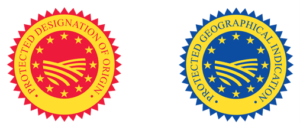![]()
The EU, which is the world leader in GI protection (more than 3,400), is strengthening its current protection and is considering what to do with those of non-agricultural products.
When and how?

GIs, i.e. protected designations of origin and geographical indications, are names that, like trademarks, distinguish a product on the market and guarantee a certain quality, but with the difference that they are linked to a certain geographical area. They are therefore tools of rural agricultural policy. The right to GIs in the EU is acquired through their registration, with effects throughout the EU.
In the EU, the current regulation of GIs refers only to agricultural products and foodstuffs, wines, and spirits; and is found in three different Regulations. For other products (non-agricultural GIs), such as glassware, textiles, musical instruments, carpets, stones, etc. the EU has not developed any law.
In November 2019, the EU ratified the Geneva Act of the Lisbon Agreement, which is an international treaty administered by WIPO ratified by more than 30 countries. The Act and the Agreement, jointly referred to as the Lisbon System, provide for a system similar to the Madrid one on the international trademark, but for GIs, i.e. a single registration process with its own database (Lisbon Express). However, the Lisbon System is not yet implemented in the EU.
In November 2020, the European Commission adopted an Intellectual Property Action Plan that devotes a section to GIs. In this Plan, the Commission states that it will strengthen the current system and will consider, based on an impact assessment, whether to propose a system of protection for non-agricultural GIs.
Among other studies and actions, the Commission launched a public consultation on the future of GIs, in which it was possible to participate until 9 April 2021.
Regarding the regulation of non-agricultural GIs, there is an intense debate. Those in favour argue that these GIs will offer producers more protection and control over the products. They also argue that rural areas, where these products are often produced, will have more investment, employment, and tourism. They also argue that consumers will be more informed about the product and that trade relations with other countries outside the EU will improve based on reciprocity in the recognition of GI protection.
However, those against regulating non-agricultural GIs argue that since the value of these products lies in the technique and materials, but not in natural factors, the link between product quality and geographical origin, which is the essence of GIs, is lost. This, they argue, may limit the free movement of the market in the EU, reduce innovation and competition, precisely because GI holders have control over production, labelling and marketing.
The policy options being considered by the EU in relation to these GIs are diverse: (i) take no action; (ii) issue recommendations that do not bind Member States; (iii) consider harmonizing national systems, as more than half already have developed domestic regulations; (iv) reform the trademark system; or (v) create a single GI protection system.
As the author of this article, from a legal point of view, I believe that this is a unique opportunity to unify the current regulation of GIs, which is dispersed, including non-agricultural GIs; and perhaps by implementing it, we will also manage to simplify Spanish laws (where we have more than 350 registered GIs), although the competence in this area has been transferred to the Autonomous Communities. This would also be consistent with the Agreements already ratified by the EU, such as TRIPS or the Lisbon Act, which do not distinguish between agricultural GIs and other types of GIs. It is also an ideal occasion, in my opinion, to review the GI registration process to make it more transparent; and to include the nuances in the protection granted by GIs, based on the recent case law handed down by the CJEU.
Personally, I believe that, in a context of globalization and considering the fact that, increasingly, there are the same chains and products in Rome as in Shanghai, preserving the know-how of handicrafts helps to maintain our identity (there is an expression in Spanish stating that “a person who loses his/her origins, loses his/her identity“). Regulating non-agricultural GIs can be a good tool for this.
Will the EU be of the same opinion?
The Action Plan sets a time horizon of the fourth quarter of 2021, to be continued….
Author: María Ceballos, Lawyer and IP Attorney at Curell Suñol SLP
Interesting links:
Database Lisbon Express
https://www.wipo.int/ipdl/en/lisbon/search-struct.jsp
IP Action Plan
https://eur-lex.europa.eu/legal-content/EN/ALL/?uri=CELEX:52020DC0760
Public Consultation


